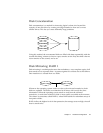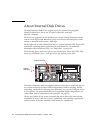
68 Sun Enterprise 220R Server Owner’s Guide • October 1999
About Peripheral Component
Interconnect (PCI) Buses
All system communication with storage peripherals and network interface devices is
mediated by a Ultra Port Architecture-to-Peripheral Component Inter-connect
(UPA-to-PCI) bridge chip, located on the system’s main logic board. This bridge chip
manages communication between the UPA bus and the system’s two PCI buses.
These PCI buses support slots for up to four PCI interface cards. One PCI bus (bus 0)
also handles communication between the system and devices connected to the main
logic board’s SCSI, FastEthernet, serial, parallel, and keyboard/mouse ports.
PCI cards come in a variety of configurations. Not all cards will fit or operate in all
PCI slots, so it is important to know the specifications of your PCI cards and the
types of cards supported by each PCI slot in the system.
Some PCI cards are as short as 6.875 inches (17.46 cm) in length (called “short”
cards), while the maximum length of PCI cards is 12.28 inches (31.19 cm, called
“long” cards). Each slot in the system can accommodate either a long or a short card.
Older PCI cards communicate over 32-bit PCI buses, while many newer cards
communicate over wider 64-bit buses. Three of the PCI slots will accept either 32-bit
or 64-bit wide cards, while the fourth is 32-bits wide.
Older PCI cards operate at 5 VDC, while newer cards are designed to operate on
3.3 VDC. Cards that require 5 volts will not operate in 3.3-volt slots, and 3.3-volt
cards will not operate in 5-volt slots. “Universal” PCI cards are designed to operate
on either 3.3 volts or 5 volts, so these cards can be inserted into either type of slot.
The system provides three slots for 5-volt cards and one slot for a 3.3-volt card.
All four PCI slots accept universal cards.
Most PCI cards operate at clock speeds of 33 MHz, while some newer cards operate
at 66 MHz. All four PCI slots can accept 33-MHz cards. 66-MHz cards are restricted
to the slot labeled PCI 1.


















